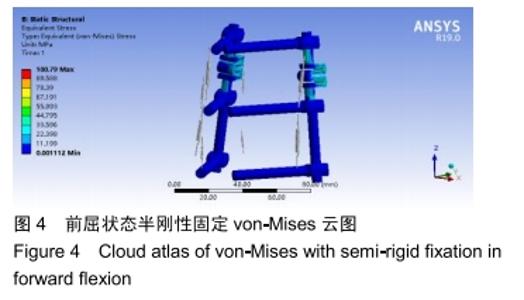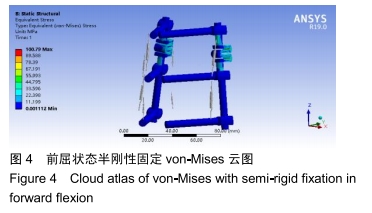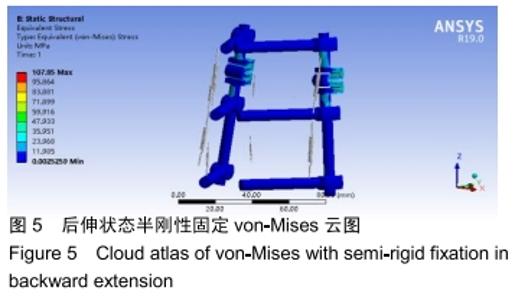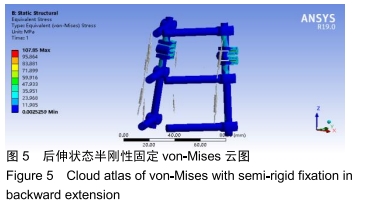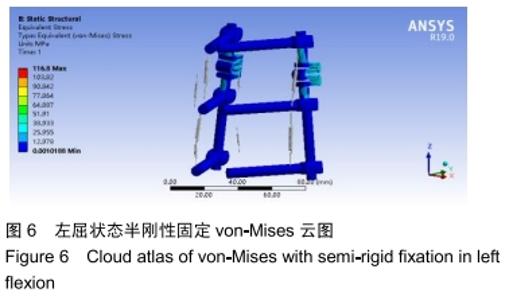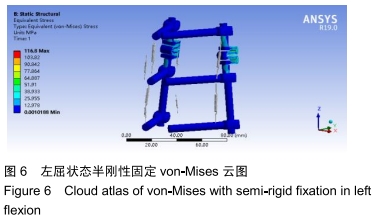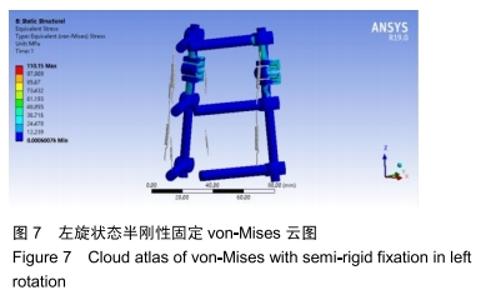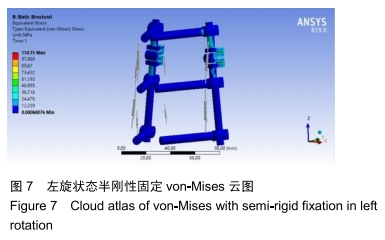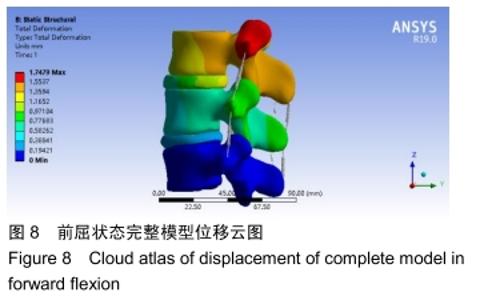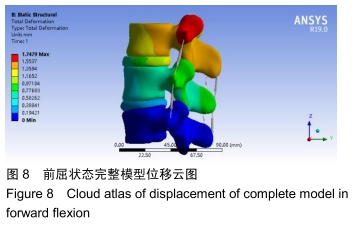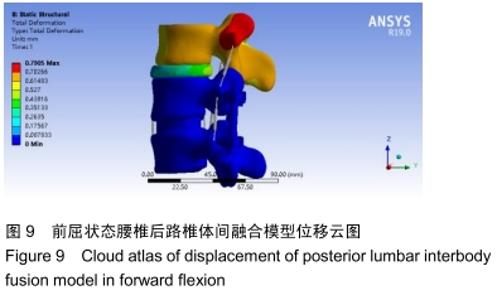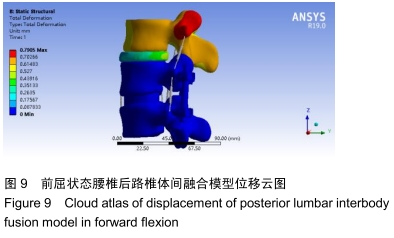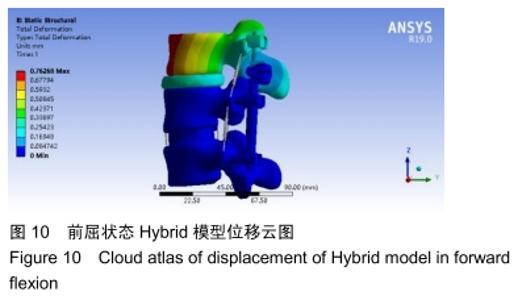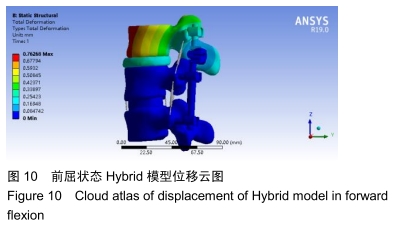Chinese Journal of Tissue Engineering Research ›› 2020, Vol. 24 ›› Issue (15): 2361-2367.doi: 10.3969/j.issn.2095-4344.2580
Previous Articles Next Articles
Finite element analysis of lumbar interbody fusion combined
with adjacent-segment semi-rigid fixation
Wang Xiao1, Tan Guoqing2, Xue Haipeng2, Xu Zhanwang2
- 1Shandong University of Traditional Chinese Medicine, Jinan 250014, Shandong Province, China; 2Department of Spine & Orthopedics, Affiliated Hospital of Shandong University of Traditional Chinese Medicine, Jinan 250014, Shandong Province, China
-
Received:2019-09-09Revised:2019-09-10Accepted:2019-10-19Online:2020-05-28Published:2020-03-22 -
Contact:Xu Zhanwang, Chief physician, Department of Spine & Orthopedics, Affiliated Hospital of Shandong University of Traditional Chinese Medicine, Jinan 250014, Shandong Province, China -
About author:Wang Xiao, Master candidate, Shandong University of Traditional Chinese Medicine, Jinan 250014, Shandong Province, China -
Supported by:the Construction Project of Inheritance Studio for Famous and Old TCM Experts in Shandong Health Committee of Shandong Province, No. LWH [2019] 92
CLC Number:
Cite this article
Wang Xiao, Tan Guoqing, Xue Haipeng, Xu Zhanwang.
Finite element analysis of lumbar interbody fusion combined
with adjacent-segment semi-rigid fixation
share this article
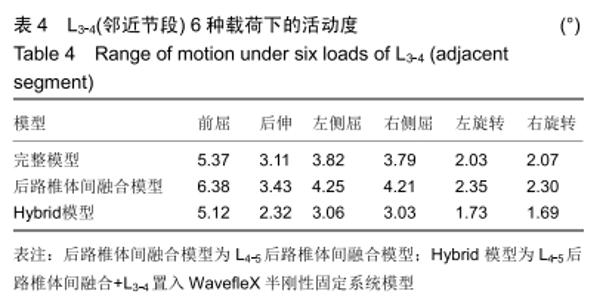
表3中可见,6种状态下,后路椎体间融合模型L3-4椎间盘无论是最大应力值,还是平均应力值均比完整模型增大。其中在前屈状态下椎间盘应力增加明显,这可能与后路椎体间融合模型后方棘上韧带、棘间韧带及黄韧带的切除有关。在6种状态下,Hybrid模型的L3-4椎间盘应力值均明显减小,在侧屈及旋转时降幅较明显,后伸时降幅最大,最大应力减少约46%,前屈时应力值降幅稍小。 从上述邻近节段椎间盘应力值变化对比可见,WavefleX半刚性固定在各个载荷状态下均能有效降低L3-4椎间盘内的应力,其作用在侧屈及旋转活动时较明显,在后伸时作用最大,前屈时影响较小。其对前屈运动保留的同时,对前屈状态异常应力集中保护能力稍差。 2.2 L3-4节段活动度比较 3种模型在前屈、后伸、左右侧弯、左右旋转6种状态下的L3-4节段(邻近节段)活动度见表4。 "
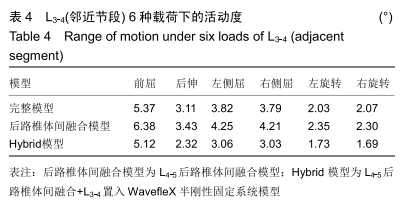
| [1] SCHMOELZ W, ERHART S, UNGER S, et al. Biomechanical evaluation of aposterior non -fusion instrumentation of the lumbar spine. Eur Spine J. 2012;21(5):939-945. [2] MOBBS RJ, PHAN K, MALHAM G, et al.Lumbar interbody fusion:techniques, indications and comparison of interbody fusion options including PLIF, TLIF, MI-TLIF, OLIF/ATP, LLIF and ALIF. J Spine Surg. 2015;1(1):2-18. [3] SÉNÉGAS J, VITAL JM, POINTILLART V, et al. Long-term actuarial survivorship analysis of an interspinous stabilization system. Eur Spine J. 2007;16: 1279-1287. [4] 张兆川,姜效韦,戴维享, 等.WavefleX弹性固定与髓核摘除纤维环修复重建腰椎间盘突出患者脊柱稳定性[J].中国组织工程研究,2015,19(44):7131-7136. [5] 朱小广,丁亮华,姜世涛,等.腰椎后路经椎弓根动态固定系统研究新进展[J].中国脊柱脊髓杂志,2011,21(3):252-255. [6] 谭国庆,甘东浩,陈德强, 等.WavefleX内固定系统在多节段腰椎退行性疾病术中的应用[J].中国骨与关节损伤杂志,2017,32(5): 508-510. [7] 马亮,许永涛,佘远举.腰椎融合联合上一节段棘突间动态固定的有限元分析[J].中国组织工程研究,2018,22(23):3647-3653. [8] CHENG CK, CHEN CS, LIU CL. Biomechanical analysis of the lumbar spine with anterior interbody fusion on the different locations of the bone grafts. Biomed Mater Eng. 2002;12(4): 367-374. [9] POLIKEIT A, FERGUSON SJ, NOLTE LP, et al. Factors influencing stresses in the lumbar spine after the insertion of intervertebral cages: finite element analysis.Eur Spine J. 2002; 12(4):413-420. [10] GOEL VK, MONROE BT, GILBERTSON LG, et al. Interlaminar shear stresses and laminae separation in a disc. Finite element analysis of the L3-L4 motion segment subjected to axial compressive loads.Spine.1976;20(6): 689-698. [11] DING JY, QIAN S, WAN L, et al. Design and finite-element evaluation of a versatile assembled lumbar interbody fusion cage. Arch Orthop Trauma Surg. 2010;130(4):565-571. [12] SONG C, LI XF, LIU ZD, et al. Biomechanical assessment of a novel L4/5 level interspinous implant using three dimensional finite element analysis. Eur Rev Med Pharmacol Sci. 2014;18(18):86-94. [13] DUAN Y, WANG HH, JIN AM, et al. Finite element analysis of posterior cervical fixation. Orthop Traumatol Surg Res. 2015; 101(1):23-29. [14] 陶勇,吴云乐,宗少晖,等.基于有限元分析腰椎内固定的生物力学特征[J].中国组织工程研究,2016,20(13):1932-1938. [15] HETH JA, HITCHON PW, GOEL VK, et al.A biomechanical comparison between anterior and transverse interbody fusion cages.Spine.2001;26(12):e26 1-e267. [16] YAMAMOTO I, PUNJABI MM, CRISCO T, et al. Three-dimensional movements of the whole lumbar spine and lumbosacral joint. Spine. 1989;14(11):1256·1260. [17] CHEN WJ, LAI PL, NIU CC, et al.Surgical treatment of adjacent instability after lumbar spine fusion.Spine. 2001;26: 519-524. [18] LAI PL, CHEN LH, NIU CC, et al.Relation between laminectomy and development of adjacent segment instability after lumbar fusion with pedicle fixation.Spine. 2004;29: 2527-2532. [19] ISHIHARA H, OSADA R, KANAMORI M, et al.Minimum 10-year follow-up study of anterior lumbar interbody fusion for isthmic spondylolisthesis.J Spinal Disord. 2001;14( 2):91-99. [20] MIYAKOSHI N, ABE E, SHIMADA Y, et al. Outcome of one-level posterior lumbar interbody fusion for spondylolisthesis and postoperative intervertebral disc degeneration adjacent to the fusion.Spine ( Phila Pa 1976). 2000;25(14) : 1837-1842. [21] 张克非,闫明,刘军.老年患者腰椎融合术后邻近节段退变的研究进展[J].实用老年医学,2015,29(11):892-894. [22] 陈辉,吴小涛,王运涛,等.腰椎后柱“骨-腱-骨”结构的完整性对邻近节段生物力学的影响[J].现代医学,2007,35(6):454-457. [23] HILIBRAND AS, ROBBINS M.Adjacent segment degeneration and adjacent segment disease:the consequences of spinal fusion.Spine. 2004;4(6 Suppl): 190-194. [24] CHEN SJ. Can hybrid constructs prevent adjacent segments degeneration? Long-term follow-up results. Spine J. 2019. [25] RAHM MD, HALL BB. Adjacent segment degeneration after lumbar fusion with instrumentation: a retrospective study. Spinal Disord.1996;9(5):392-400. [26] RADCLIFF KE, KEPLER CK, JAKOI A, et al. Adjacent segment disease in the lumbar spine following different treatment interventions. Spine J. 2013;13(10):1339-1349. [27] KASHKOUSH A, AGARWAL N, PASCHEL E, et al. Evaluation of a hybrid dynamic stabilization and fusion system in the lumbar spine: a 10 year experience. Cureus. 2016;8(6):e637. [28] NACHANAKIAN A, EL HELOU A, ALAYWAN M. Posterior dynamic stabilization:The interspinous spacer from treatment to prevention. Asian J Neurosurg. 2016;11(2):87-93. [29] LEE SE, JAHNG TA, KIM HJ. Facet joint changes after application of lumbar nonfusion dynamic stabilization. Neurosurg Focus. 2016;40(1):E6. [30] CABELLO J, CAVANILLES-WALKER JM, IBORRA M, et al. The protective role of dynamic stabilization on the adjacent disc to a rigid instrumented level. An in vitro biomechanical analysis. Arch Orthop Trauma Surg. 2013;133(4):443-448. [31] LIU HY, ZHOU J, WANG B, et al. Comparison of topping-off and posterior lumbar interbody fusion surgery in lumbar degenerative disease: a retrospective study. Chin Med J. 2012;125(22):3942-3946. [32] 胡明,马远征,李大伟,等.WavefleX动态稳定系统治疗腰椎退变性疾病的早期临床观察[J].中国骨与关节外科, 2013,6(2): 113-116. [33] 薛有地,王栋,戴维享,等.WavefleX内固定系统治疗多节段腰椎退变疾病的中期疗效[J].中国修复重建外科杂志, 2015,29(9): 1104-1108. |
| [1] | Xu Feng, Kang Hui, Wei Tanjun, Xi Jintao. Biomechanical analysis of different fixation methods of pedicle screws for thoracolumbar fracture [J]. Chinese Journal of Tissue Engineering Research, 2021, 25(9): 1313-1317. |
| [2] | Jiang Yong, Luo Yi, Ding Yongli, Zhou Yong, Min Li, Tang Fan, Zhang Wenli, Duan Hong, Tu Chongqi. Von Mises stress on the influence of pelvic stability by precise sacral resection and clinical validation [J]. Chinese Journal of Tissue Engineering Research, 2021, 25(9): 1318-1323. |
| [3] | Yao Rubin, Wang Shiyong, Yang Kaishun. Minimally invasive transforaminal lumbar interbody fusion for treatment of single-segment lumbar spinal stenosis improves lumbar-pelvic balance [J]. Chinese Journal of Tissue Engineering Research, 2021, 25(9): 1387-1392. |
| [4] | Chen Xinmin, Li Wenbiao, Xiong Kaikai, Xiong Xiaoyan, Zheng Liqin, Li Musheng, Zheng Yongze, Lin Ziling. Type A3.3 femoral intertrochanteric fracture with augmented proximal femoral nail anti-rotation in the elderly: finite element analysis of the optimal amount of bone cement [J]. Chinese Journal of Tissue Engineering Research, 2021, 25(9): 1404-1409. |
| [5] | Pei Lili, Sun Guicai, Wang Di. Salvianolic acid B inhibits oxidative damage of bone marrow mesenchymal stem cells and promotes differentiation into cardiomyocytes [J]. Chinese Journal of Tissue Engineering Research, 2021, 25(7): 1032-1036. |
| [6] | Li Shanshan, Guo Xiaoxiao, You Ran, Yang Xiufen, Zhao Lu, Chen Xi, Wang Yanling. Photoreceptor cell replacement therapy for retinal degeneration diseases [J]. Chinese Journal of Tissue Engineering Research, 2021, 25(7): 1116-1121. |
| [7] | Cai Qunbin, Zou Xia, Hu Jiantao, Chen Xinmin, Zheng Liqin, Huang Peizhen, Lin Ziling, Jiang Ziwei. Relationship between tip-apex distance and stability of intertrochanteric femoral fractures with proximal femoral anti-rotation nail: a finite element analysis [J]. Chinese Journal of Tissue Engineering Research, 2021, 25(6): 831-836. |
| [8] | Hou Guangyuan, Zhang Jixue, Zhang Zhijun, Meng Xianghui, Duan Wen, Gao Weilu. Bone cement pedicle screw fixation and fusion in the treatment of degenerative spinal disease with osteoporosis: one-year follow-up [J]. Chinese Journal of Tissue Engineering Research, 2021, 25(6): 878-883. |
| [9] | Yang Weiqiang, Ding Tong, Yang Weike, Jiang Zhengang. Combined variable stress plate internal fixation affects changes of bone histiocyte function and bone mineral density at the fractured end of goat femur [J]. Chinese Journal of Tissue Engineering Research, 2021, 25(6): 890-894. |
| [10] | Song Chengjie, Chang Hengrui, Shi Mingxin, Meng Xianzhong. Research progress in biomechanical stability of lateral lumbar interbody fusion [J]. Chinese Journal of Tissue Engineering Research, 2021, 25(6): 923-928. |
| [11] | Liu Zhao, Xu Xilin, Shen Yiwei, Zhang Xiaofeng, Lü Hang, Zhao Jun, Wang Zhengchun, Liu Xuzhuo, Wang Haitao. Guiding role and prospect of staging and classification combined collapse prediction method for osteonecrosis of femoral head [J]. Chinese Journal of Tissue Engineering Research, 2021, 25(6): 929-934. |
| [12] | Liu Xin, Yan Feihua, Hong Kunhao. Delaying cartilage degeneration by regulating the expression of aquaporins in rats with knee osteoarthritis [J]. Chinese Journal of Tissue Engineering Research, 2021, 25(5): 668-673. |
| [13] | Yang Yang, Yao Yu, Shen Xiaotian, Liu Jiajia, Xue Jianhua. Expression and significance of interleukin-21 in intervertebral disc degeneration [J]. Chinese Journal of Tissue Engineering Research, 2021, 25(5): 690-694. |
| [14] | Xu Yinqin, Shi Hongmei, Wang Guangyi. Effects of Tongbi prescription hot compress combined with acupuncture on mRNA expressions of apoptosis-related genes,Caspase-3 and Bcl-2, in degenerative intervertebral discs [J]. Chinese Journal of Tissue Engineering Research, 2021, 25(5): 713-718. |
| [15] | Xie Chongxin, Zhang Lei. Comparison of knee degeneration after anterior cruciate ligament reconstruction with or without remnant preservation [J]. Chinese Journal of Tissue Engineering Research, 2021, 25(5): 735-740. |
| Viewed | ||||||
|
Full text |
|
|||||
|
Abstract |
|
|||||


